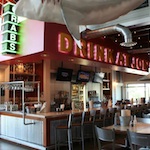The Roosevelt, a Waldorf-Astoria Hotel
New Orleans
Started
2008
Completed
2010
Cost
$145 million
Building Type
Hotel
1
After Hurricane Katrina, the historic Fairmont Hotel was in poor condition, but Waldorf Astoria saw an opportunity. The hospitality chain purchased the property and commissioned Paradigm Design Group to renovate it, and when it opened with a new name, The Roosevelt, Haude and local New Orleanians celebrated it as a rebirth of luxury in the city. “I was honored when my firm was asked to take this project,” Haude says. “The Roosevelt is an icon for the city of New Orleans. Renovating this hotel was a subtle statement for the city that New Orleans is back.”
The renovation took two years and involved the complete gutting of the public areas, the spa, the restaurant, and more than 500 guest rooms. For several months, Haude researched the history of the structure, tracing many of its design elements back to when it first opened as the Grunewald Hotel in 1893. One historic detail she preserved was a mosaic-tile floor she found buried under carpeting. She had the tiling replicated and extended from door to door.
Paradigm Design Group is also in charge of outfitting a newly added restaurant space that will be completed in 2013. It is adjacent to the famous Sazerac Bar, and Haude wants the space to replicate the feel of the building’s old Fountain Lounge, which was popular during WWII.
“We reinvented the space to bring in more energy,” Haude says. “We wanted to represent the history of the people and restore the grandeur that was once here.”


The Park Vista, a Doubletree Hotel
Gatlinburg, TN
Started
2009
Completed
2010
Cost
$11 million
Building Type
Hotel
2
The southern edge of Gatlinburg runs right along the border of Great Smoky Mountains National Park, an 816-square-mile swath of gently rising peaks covered densely with trees. Sitting immediately at the base of these grand hills is the Park Vista, a formerly independent hotel that the Doubletree Hotel company recently bought and wanted repositioned as part of its brand. It hired Paradigm Design Group to do the work.
“Our job,” Haude says, “was to embrace the setting and create a hotel that looked like it belonged there.”
In the public areas, the ballroom, the boardroom, the restaurant, and the 300 guest rooms, Haude chose upscale Arts and Crafts-style furnishings to complement the original rustic, woodsy, lodge-inspired setting. She and her team also used wood and stone finishes throughout the building to create a more seamless flow from exterior to interior.
“We wanted to mimic the feel of the mountains,” Haude says. “We redesigned the whole atmosphere of the hotel and gave it a sense of place and environment. It fits the beauty of the area.”
The result is a hotel with plenty of cozy charm, but it’s also outfitted to satisfy the needs and inclinations of the modern consumer. ABQ




